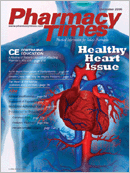Publication
Article
Pharmacy Times
case STUDIES
Author(s):
CASEONE:ES, a 50-year-old male on a2-week vacation with his family,presents to the mountainresort's infirmary complainingof 3 days of abdominal crampsand diarrhea. He describes thediarrhea as initially lookingclear but has become bloodyand more voluminous. He also reports experiencing headacheand malaise. Although he did not have a thermometer, hebelieves he has been running a fever for the last 2 days.
During the workup, the physician learns that ES has a historyof angina and congestive heart failure. Prior to thisvacation, ES had not experienced any chest pain in 4 weeks.He does routinely require 2 pillows to assist his breathingwhile sleeping. Over the last 24 hours, ES reports experiencingfrequent episodes of chest pain along with shortnessof breath on exertion.
The physician documents the following findings on physicalexamination:
- Vital signs: blood pressure, 170/95 mm Hg; heart rate, 105;respiratory rate, 25; temperature, 38.6ºC; weight, 100 kg
- General: well-developed, obese male in mild distress
- Head, eyes, ears, nose, and throat: dry mucous membranes,mild jugular venous distention
- Coronary: regular rate and rhythm without murmur
- Abdomen: soft, nontender
- Extremities: 1+ lower extremity edema
- A culture of ES' stool revealed organisms of the Salmonellaspecies
If ES had presented with mild or asymptomatic Salmonelladiarrhea, the physician would not prescribe antibiotics. In lightof the severity of ES'diarrhea in combination with his chestpain and shortness of breath, the clinician decides to treat ESwith antibiotics. After confirming that ES does not have anymedication allergies, the clinician searches the infirmary'smedicine supply for an appropriate antibiotic. In the medicationcloset, he finds:
10 tablets of azithromycin, 250 mg
25 capsules of penicillin, 250 mg
14 tablets of ciprofloxacin, 500 mg
25 tablets of cefuroxime, 500 mg
Which antibiotic, and at what dose and length of therapy,should the clinician choose to treat ES' diarrhea?
CASE TWO:While on semester breakfrom pharmacy school, MLjoins a medical missionary tripto a developing country. Nearthe end of the trip, ML developssevere diarrhea. Alongwith more than 5 unformedstools per day, he also hasabdominal cramping and nausea.He has a high fever accompanied by shaking chills. Whenhe notices blood in his stool, ML decides his diarrhea is severeenough to warrant care from the trip's physician.
With no means available for culturing stool, the physicianmust choose an antibiotic to treat ML's diarrhea withoutknowing the identity of the offending bacteria. The physicianexplains that 75% of dysentery cases are caused by bacteria,with more than 50% caused by Escherichia coli. He alsoexplains the importance of covering for Shigellae becausethe presence of bloody diarrhea is suspicious for shigellosis.
When the physician and ML examine the antibiotic supply,they are disappointed to see that there are only a fewdoses of antibiotics still available. The available medicationsinclude:
20 tablets of ciprofloxacin, 500 mg
6 tablets of sulfamethoxazole-trimethoprim, double strength
30 capsules of penicillin VK, 250 mg
25 capsules of cephalexin, 500 mg
The physician decides to use the opportunity to test ML'sknowledge of antibiotic spectrums of activity. He asks ML todetermine which medication, at what dose, and for howlong would be best considering the limited supply.
What antibiotic and regimen should ML select?
Dr. Schlesselman is an assistant clinical professor at the University of Connecticut School of Pharmacy.
Click Here For The Answer ----------->
[-]
CASE ONE: Of the available medications, only azithromycin and ciprofloxacin exhibit activity against Salmonella species. The recommendeddose of ciprofloxacin for the treatment of Salmonella diarrhea is 500 mg twice daily for 3 to 7 days. For azithromycin, the recommended regimenis 1 g for one dose, followed by 500 mg daily for 6 days. Since the supply of azithromycin is inadequate to complete the course of therapy, the clinicianshould choose ciprofloxacin.
CASE TWO: ML should select ciprofloxacin 500 mg twice daily. Penicillin and cephalexin do not exhibit activity against ML's suspected shigellosis.Ciprofloxacin and sulfamethoxazole-trimethoprim exhibit activity against E coli and Shigellae. Unfortunately, the supply of sulfamethoxazole-trimethoprimis inadequate to treat shigellosis. For the treatment of shigellosis, antibiotics should be initiated as soon as possible after diarrhea begins and continuedfor 5 days.
toggle(getObject('exp1048685570_link'), 'exp1048685570');







